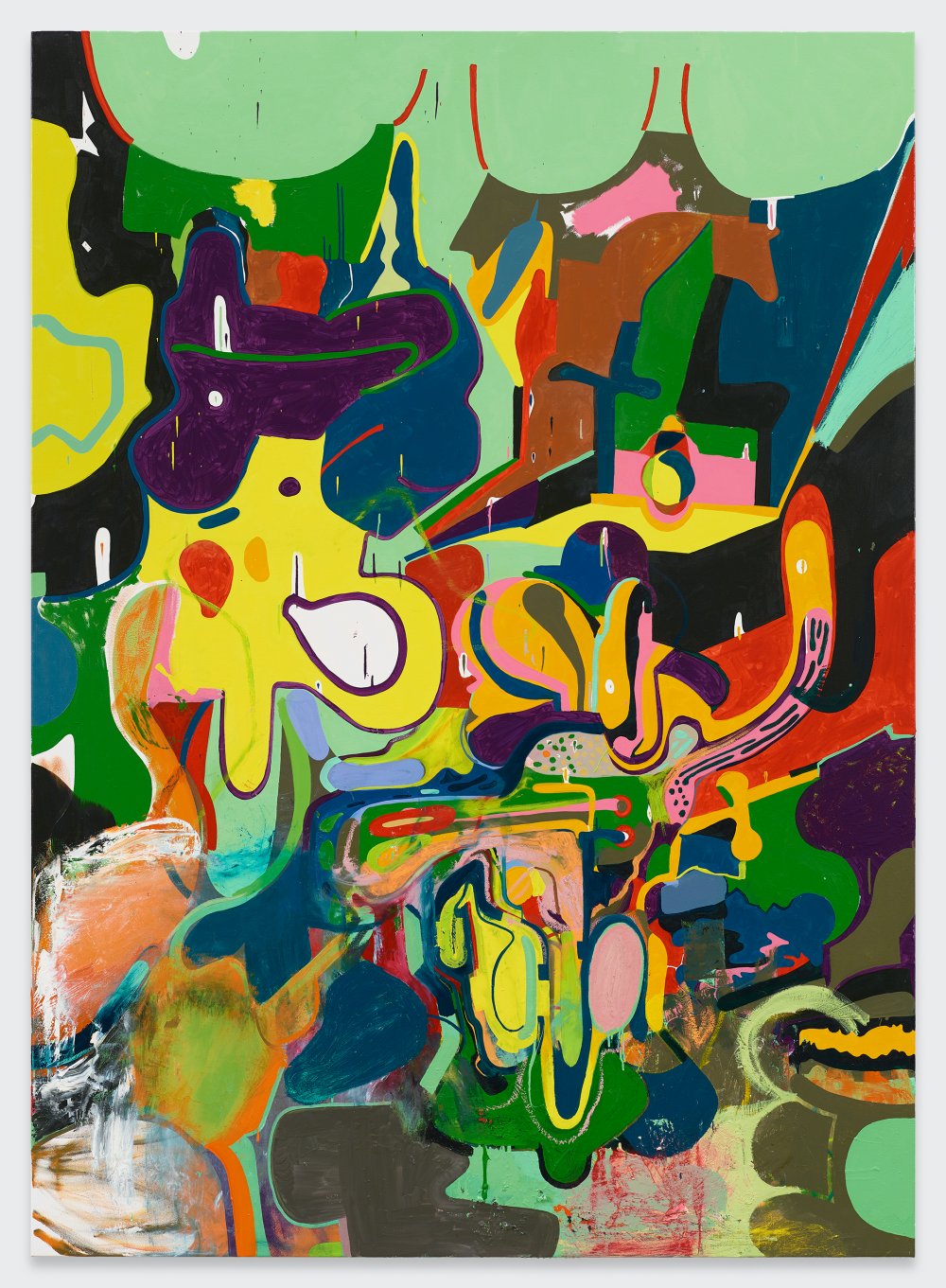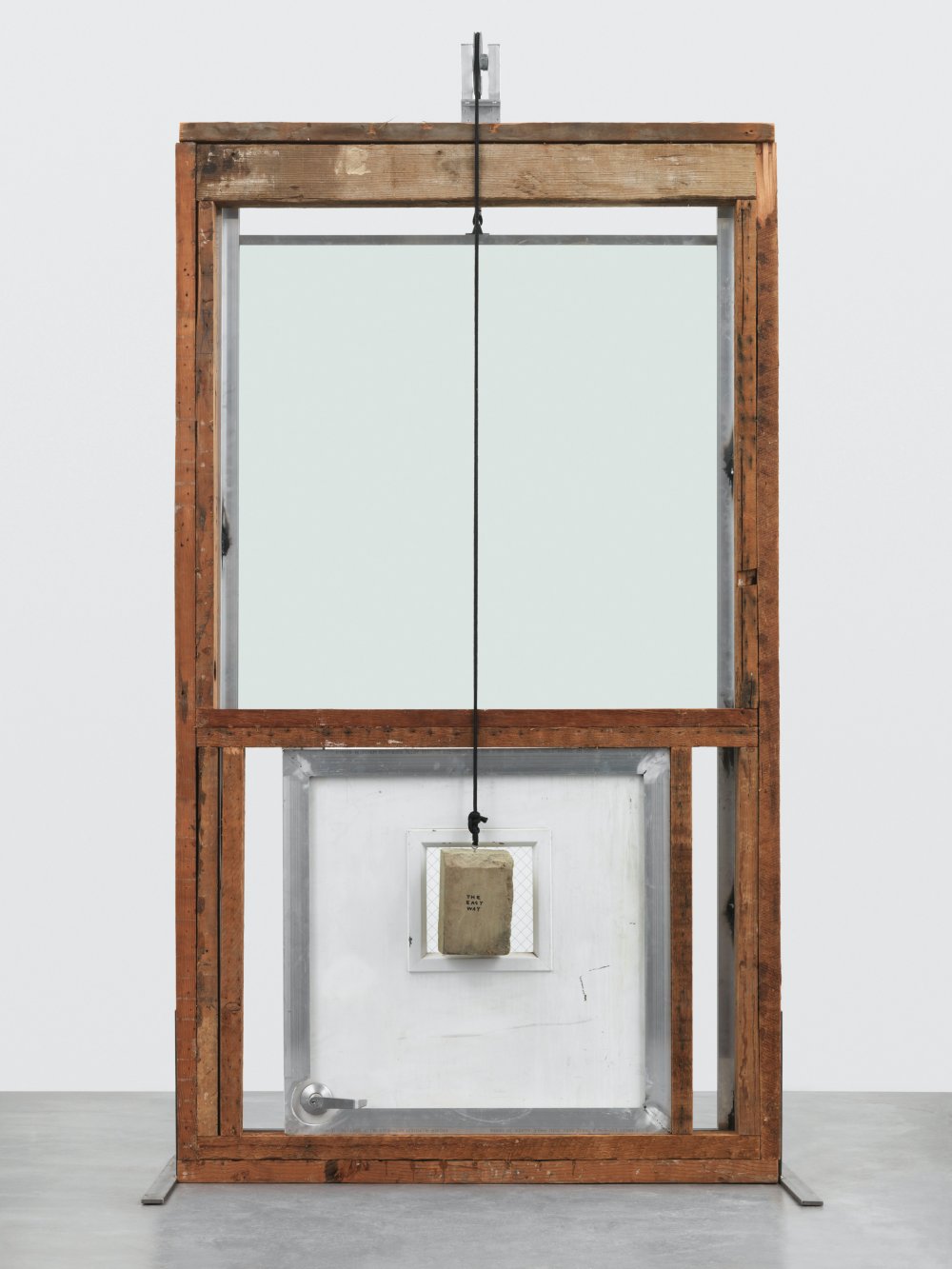Open: Wed-Fri 12-6pm, Sat 11am-5pm & by appointment
Visit
Group Show
Galerie Eva Presenhuber, Maag Areal, Zürich
Fri 12 Jun 2020 to Sat 18 Jul 2020
Zahnradstrasse 21, CH-8005 Group Show
Wed-Fri 12-6pm, Sat 11am-5pm & by appointment
Jean-Marie Appriou, Joe Bradley, Valentin Carron, Verne Dawson, Carroll Dunham, Peter Fischli David Weiss, John Giorno, Alex Hubbard, Shara Hughes, Wyatt Kahn, Karen Kilimnik, Adam Pendleton, Tobias Pils, Ugo Rondinone, Tschabalala Self, Steven Shearer, Oscar Tuazon, Michael Williams
Jean-Marie Appriou’s (born 1986 in Brest, FR) sculptures evoke archaic forms and are inspired by contemporary, but also mythological and futuristic worlds. His works are often crafted from the very modern material of aluminum, the design possibilities of which the artist constantly expands upon through experimentation and in combination with other metals. By alluding to familiar forms, be they animal or human, and developing his unique, almost alchemical approach to his source material, Appriou has created his very own mythology.
Joe Bradley’s (born 1975 in Kittery, ME, US) versatile painterly oeuvre is based on a complex visual language. His groups of works vary between primitive iconology, gestural abstraction, and a radical, hard-edge attitude. Bradley envisages the tradition of painting and art in its more general definition as a shared, historically enriched space, a space within which every artist who has painted and who is painting is present. This forces the viewer to understand his practice not necessarily as a movement forward but as an ongoing conversation, and thus comprehend that Bradley might return to earlier series or motifs.
In his sculptures and collages, Valentin Carron (born 1977 in Martigny, CH) imitates traditional handicrafts and unknown artworks, as well as stereotypical modern and everyday forms. By appropriating these objects and styles, he questions originality, authenticity, and identity in the globalized world. He reformulates traditional handicrafts, mainly from his Swiss homeland, by substituting natural materials like wood for synthetic materials; conversely, he commissions well-trained craftsmen to create precious works imitating cheap industrial articles.
Verne Dawson’s (born 1961 in Meridianville, AL, US) approach to painting is that of an anthropologist studying ancient concepts of time and space, how they have affected humankind throughout its social and technical evolution, and in what way they are still present in our contemporary, everyday culture. He bridges the gap between past and present by dealing with astronomy, numerology, and myth, as the ideas and stories behind these fields continue to impact the way we perceive and experience life.
Since the 1980s, Carroll Dunham (born 1949 in New Haven, CT, US) has developed his visual style while creating a significant oeuvre encompassing painting, drawing, print, and sculpture. Minimalist at the outset, his abstract but organic forms became increasingly concrete, depicting series of recurrent figures. In 2013, Dunham painted his first wrestlers, a subject that is unexpected enough in the context of his practice and subsequently with regard to his formal approach past and present. The works show two nude men, who closely resemble each other, trying to pin each other down in an ongoing brawl, neither seeming to prevail over the other.
Peter Fischli (born 1952 in Zurich, CH) and David Weiss (born 1946 in Zurich, CH; died 2012 in Zurich, CH) began collaborating in 1979 and created a significant body of work, which combined, rearranged, and even manipulated their daily experiences into something new and unexpected. Employing various media, including unfired clay, rubber, photography, and video, Fischli Weiss managed to playfully fuse the two ends of high and low art. The artist duo’s rubber sculptures are 1:1 scale replicas of individual objects such as a heart, a plant, or a piece of furniture, and were first exhibited in a group show at Galerie Beyeler in Basel in 1986.
John Giorno (born 1936 in New York, NY, US; died 2019 in New York, NY, US) is remembered for his remarkable spirit and craft, which expanded, transcended, and challenged the borders of different art forms. No other artist has woven poetry, visual art, sound performance, and dance as succinctly as Giorno did, while radically questioning their boundaries and interdependencies. In his Poem Paintings, Giorno transformed phrases originally found in his poems into bold, visual works. Explosive lines like “SPACE FORGETS YOU” and “YOU GOT TO BURN TO SHINE” provoke both identification and further contemplation.
Alex Hubbard (born 1975 in Toledo, OR, US) is a painter and video artist. He weaves together both fields by using the same approach in each medium and thereby rethinks video, painting, and their connections. In his paintings, Hubbard uses the volatile, fast-drying materials of urethane, resin, and fiberglass. Once applied to the surface, these materials cannot be changed. Therefore, his paintings—like the videos—always have the potential to unmoor themselves from their original plan. This gives the paintings a lot of space for unpredictabilities to take place during the process. This genesis, which leaves its traces in both the videos and paintings, creates the sometimes absurd, sometimes funny, and sometimes dramatic attraction of Hubbard's works.
Shara Hughes (born 1981 in Atlanta, GA, US) refers to her paintings as psychological or invented landscapes, a term that derives from her working process and describes the way her paintings are created only in the very moment of painting. Hughes states that during painting, her works are created purely from the inside; this inside, however, is strongly informed by a deep knowledge of art history as well as the work of contemporary peers, as her frenetic colors and vibrant brushstroke, encompassing everything from monochromatic fields to harsh lines and dots, show. Fin de siècle styles, such as Fauvism, Art Nouveau, or German Expressionism, appear in her work alongside traces of contemporary painters such as Carroll Dunham, Sanya Kantarovsky, or David Hockney.
Wyatt Kahn’s (born 1983 in New York, NY, US) most recent body of work is, weirdly if paradoxically, as tough as it is vulnerable. Working with sheets of lead, oil stick, and shaped stretchers, Kahn constructs what can be considered, for lack of a better term, “specific objects.” Neither painting nor sculpture, in the strict sense of the art forms, they are both, and more. The artist’s three-dimensional wall works draw on a formal figurative reference, which becomes so abstracted as to take on an obscure semiotic or linguistic complexion. Kahn also considers these “signs” flattened characters based on people from his immediate milieu.
Beginning in the 1990s, Karen Kilimnik (born 1955 in Philadelphia, PA, US) has created a large oeuvre of paintings in which she deals with romantic mysteries, nature, Baroque, Rococo, fairy tales, and ballet. Artists such as 17th and 18th century painters Henry Raeburn, George Stubbs, Hubert Robert or François Boucher are frequent subjects to her reinterpretation. Kilimnik’s oil paintings appear rather traditional, except that they tell of a sense of tradition that the artist does not derive from her reflection on the art of the past but a critical imagination and preoccupation of classical themes such as nature, proportions, or optical illusions.
Adam Pendleton (born 1984 in Richmond, VA, US) is a conceptual artist known for his multi-disciplinary practice, which moves fluidly between painting, publishing, photographic collage, video, and performance. His work centers on an engagement with language, in both the figurative and literal senses, and the recontextualization of history through appropriated imagery to establish alternative interpretations of the present and, as the artist has explained, “a future dynamic where new historical narratives and meanings can exist.”
Tobias Pils' (born 1971 in Linz, AT) paintings and graphic works are almost beyond interpretation. His painting process is characterized by planning, which then negates itself throughout its execution. As a result, representation flips into abstraction, figuration turns into composition. Pils' work creates an unease of interpretation and challenges the notion of subjectivity in painting: His method follows intuition and is created in the context of the painter’s everyday.
Ugo Rondinone (born 1964 in Brunnen, CH, lives in New York, NY, US). The brick wall, a symbol of containment and isolation, has frequently been used in different mediums by Ugo Rondinone. The painting ‘vierteraprilzweitausendundneuzehn’ is a confrontational freestanding brick painting on burlap. The bricks are painted in thick-layered oil paint. While the front of the painting shows an organized grid of painted bricks, the back reveals the canvas as patchwork, composed of individual pieces of burlap, held together with big visible stitches. This instance of opposition between the two sides of the painting is also informed by the artist's biography: his father was a bricklayer and his mother a seamstress.
The door sculpture 'healing hollow halt' is like the brick painting, a symbol of introversion and seclusion. The door, put together like a puzzle from several pieces of driftwood, is absolutely impenetrable. The austere sculpture appears introverted and oracular; the door is also subverted by the larger-than-life, almost cartoon-like presence. The door sculpture dwarfs the viewer before it and contains no concrete answer as to who is being contained, to where the door might lead, or if we are being shut out. As a consequence, the sculpture directs our view inward. Each individual door sculpture is titled with a triple word, that starts with a letter of the alphabet. The group of door sculptures, which Ugo Rondinone started in 2006, will be completed once every letter of the alphabet has been used.
Tschabalala Self (born 1990 in New York, NY, US) engages the overarching history of art making by foregrounding the human body in her work. However, she refers to her painted characters as “avatars,” placing them in conversation with the digital age, even as her decidedly handmade process engages with tradition. Through technology and social media, we create virtual personas assembled from parts of ourselves we want to highlight; Self’s collaged characters may be seen as tactile extensions of that principle. These images emerge from personal exploration and an investigation of identity... The discordantly patterned fabrics combine into bodies that exaggerate curves and simplify features but ultimately resolve into figures with scale and presence. Self’s characters are typically nude and often in intimate settings, finding power rather than vulnerability in the exposure of the human form.
For more than 20 years, Steven Shearer (born 1968 in New Westminster, BC, CA) has worked with a wide range of materials such as print, sculpture, painting, drawing, and collaged found photography. Shearer has become increasingly well known for his adept portraits of figures painted within interior spaces. These portraits recall figures from past music subcultures and art historical painting and are rendered employing stylistic references from Fauvism and Symbolism to German Romantic Art. Reconfiguring Renaissance systems of perspective, he creates complex perspectival elements within the compositions that animate the viewer’s engagement with his paintings.
The sculptor Oscar Tuazon (born 1975 in Seattle, WA, US) works with natural and industrial materials to create inventive objects, structures, and installations that can be used, occupied, or otherwise engaged by viewers. With a strong interest in and influence from architecture and minimalism, Tuazon turns both disciplines on their heads as he mangles, twists, combines, and connects steel, glass, and concrete as well as two-by-fours, tree trunks, and found objects. Tuazon produces objects and environments that draw out humanity’s relationship to buildings, interior and exterior spaces, and other objects and structures.
Using his representational drawings as appropriated images, Michael Williams (born 1978 in Doylestown, PA, US) works through an analog process of drawing and collage to produce the source images for his Puzzle Paintings. The finished canvases present a discontinuous whole and summon the fragmented nature of our contemporary everyday. Whether Williams composes his paintings on canvas or screen, they are informed by art history and pop- cultural iconography, whilst nonetheless leaving space for unexpected events to occur during the process. As a result, they emanate a sometimes ironic, sometimes funny tension that is always seductive to the eye.










































